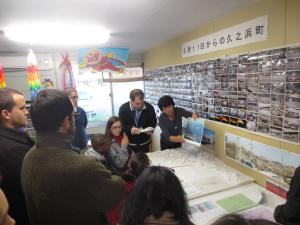In the middle of November, a group of Assistant Language Teachers of various nationalities from all over Fukushima came together to view first hand some of the effects that the March 2011 Earthquake and Tsunami had on Fukushima and its people. Our first stop was at the Fukushima Agricultural Technology Centre which is reasonably close to Koriyama. Here we learned how Fukushima`s produce is rigorously tested on a regular basis to check if it`s safe for consumption. They sample many types of produce every day and use huge 1.5 ton Germanium Semiconductor Detectors. What was particularly interesting is that Japan`s standard value for radioactive cesium is 100becquerels/kg. While that sounds like a lot, both Europe and the USA have limits of 1000becquerels/kg. I have never been particularly worried about the produce of Fukushima but upon hearing this information my confidence was boosted tenfold. Afterwards, we travelled to Iwaki and were shown around various places such as Tomato land (which sells very delicious tomatoes of varying sizes), a Kamaboko factory, an organic cotton field and a beautiful temple. But the location that stood out for me was Hisanohama. Hisanohama is a small coastal town that was devastated by the disaster 2 years ago. We visited a temporary shopping district setup outside of the local school as the former one was destroyed. We heard of one woman`s experience and how she left her car and ran to higher ground for safety. While we were listening to the woman`s story, we were surrounded by photos that were laid out like a timeline. I was quite upset when I heard her story and after she finished telling us her experience, we explored the temporary shopping district. It was very small, but had the daily necessities, but the most impressive thing about this area was the people`s perseverance. Even though, they had lost loved ones and experienced terrible things, they still had a sparkle in their eye and a smile on their face. I was moved by and inspired by their confidence to persevere and never give up. While this was especially apparent in Hisanohama, this is also true for the other locations in Iwaki. Many of the locations we visited see the disaster as an opportunity for growth and an opportunity to change. I truly admire the people of Iwaki and all of Fukushima and if anyone has an opportunity to go on a study trip like we did. I highly recommend it, it was a true eye opener and a valuable experience. |  |
| Summary |







